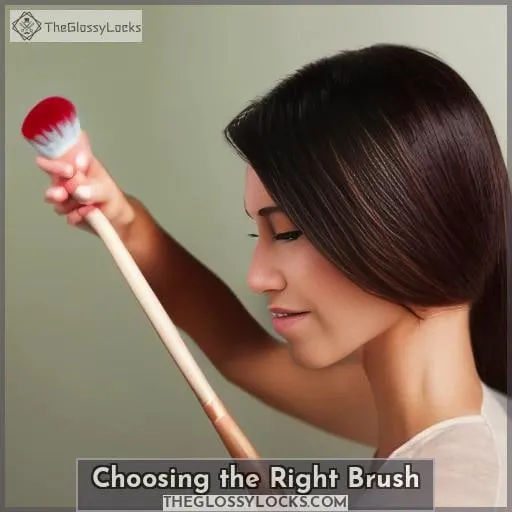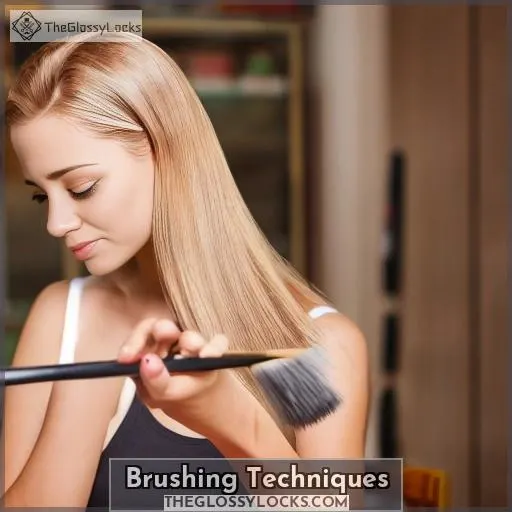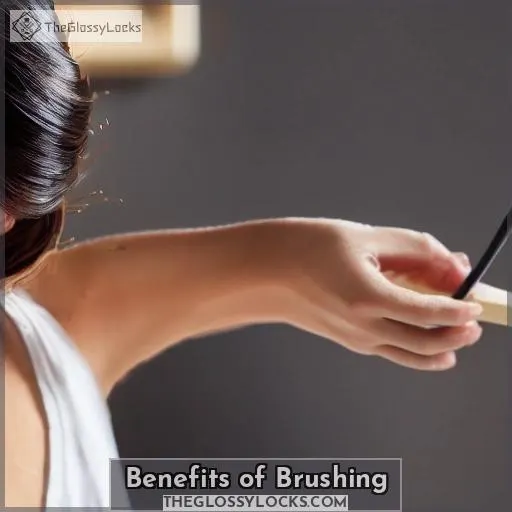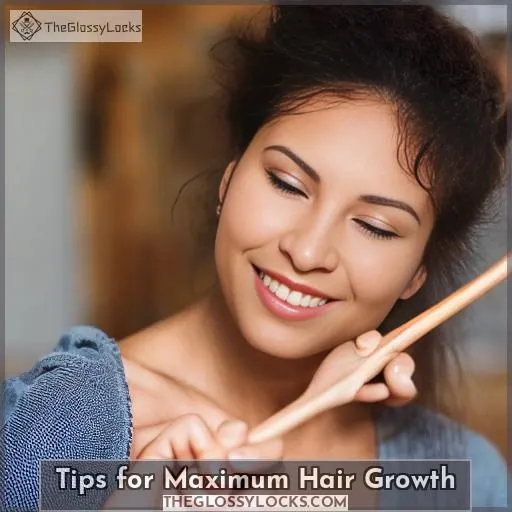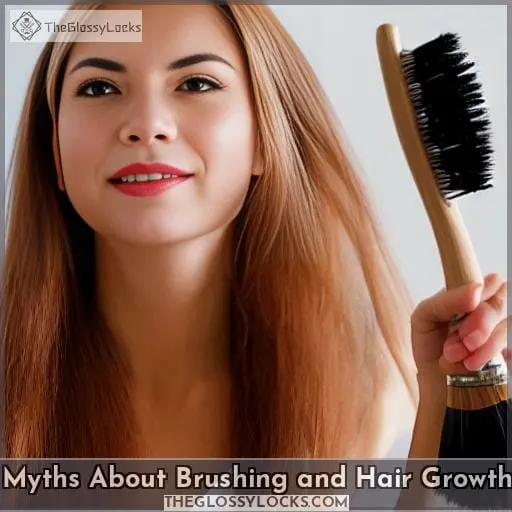This site is supported by our readers. We may earn a commission, at no cost to you, if you purchase through links.
Do you ever feel like your hair just isn’t growing as fast and strong as it used to? If so, then you may be surprised to know that the answer could be found in something as simple and straightforward as brushing your hair.
That’s right – not only is proper brushing technique important for keeping scalp health optimal, but it can actually stimulate growth by improving circulation and strengthening locks. With a few tips on choosing the best brush for your needs, understanding how often to brush plus some common myths debunked – this article will have you well on your way towards achieving maximum length!
So why wait? Let’s dive in headfirst into exploring whether or not brushing really does help with stimulating hair growth!
Table Of Contents
Importance of Scalp Health
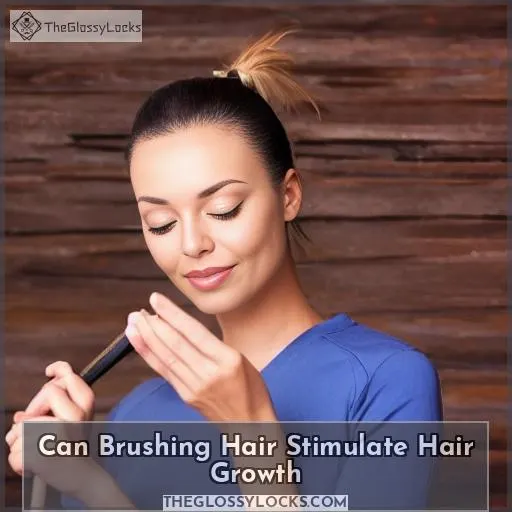
You might not think much about your scalp, but it’s essential for healthy hair growth. Brushing your hair can help stimulate blood circulation in the scalp, which helps increase sebum production and provide nourishing oils to the follicles. All of these promote healthier and faster growing hair.
So don’t underestimate how important it is to take care of your scalp. Regular brushing could be just what you need!
Blood Circulation
Massaging your scalp can help increase blood flow and promote healthier hair growth. To achieve optimal results, consider these tips:
- Use a brush with soft bristles and natural oils to gently massage your scalp while shampooing to care for your cuticles.
- Massage your scalp for a few minutes daily to stimulate circulation and improve nutrient absorption for healthy hair growth.
- Be cautious of using hot tools or getting frequent trims, as they can cause breakage that inhibits proper blood flow and hinders healthy hair regrowth.
Remember to take care of your scalp for healthier hair!
Sebum Production
Regularly stimulating your scalp helps to promote the natural production of sebum, which is essential for strong and healthy hair. Using a wide-toothed comb or detangling cream can help stimulate the circulation on your scalp while gently massaging with jojoba oil stimulates hair growth.
Additionally, use cold-water rinses after shampooing and follow it up by applying natural oils like coconut or almond as they contain vitamins that nourish your follicles and prevent further damage from occurring. With proper scalp stimulation along with using products specifically designed for promoting healthy growth such as those mentioned above, you can reduce any potential chances of experiencing serious levels of hair loss due to lack of sebum production in areas where it has been depleted over time.
Choosing the Right Brush
When it comes to brushing your hair, the type of brush you use is important. The type of bristles, shape, and size of the brush, as well as whether or not you choose a detangling one, will all make a difference in how much stimulation for growth your scalp receives.
Selecting natural boar bristle brushes is best for stimulating follicles due to their soft texture, which helps evenly distribute oils from root to tip while also being gentle on strands. Longer rectangular-shaped brushes help reach deeper and wider parts of hairs, while rounder ones can be used on shorter layers. Finally, detangling brushes with wide teeth are ideal for getting rid of knots without breakage so that those healthy locks can grow strong!
Bristle Type
By selecting the appropriate bristle type for your hair, you can maximize its potential for healthy growth. Brush materials play a key role in determining the effectiveness of your brushing routine.
Boar-bristle brushes are highly recommended as they help distribute natural oils throughout your hair and gently massage the scalp to increase blood flow and stimulate hair follicles. On the other hand, plastic bristles may cause damage to the cuticle of your hair if used too aggressively or frequently.
Additionally, paddle brushes are great for detangling thick or curly textures but should be avoided by those with fine or thinning strands as they may pull on delicate hairs causing breakage. When considering brush durability, investing in high-quality options such as boar-bristle brushes will ensure longevity and overall cost-effectiveness over time.
Lastly, cleaning frequency is crucial to maintaining optimal hygiene and preventing product buildup which can clog pores on our scalp leading to irritation or even infection – aim to clean every 1-2 weeks depending on usage frequency.
| Brush Material | Hair Texture | Scalp Massage | Durability | Cleaning Frequency |
|---|---|---|---|---|
| Boar Bristle | -Ideal | -Stimulates Blood Flow & Follicles | -Highly Durable & Long-Lasting | –Clean Every Few Weeks |
| Plastic Bristle | -Not Ideal | -May Damage Cuticle If Used Too Aggressively/Frequently | -Less Durable Than Natural Materials | –Clean Weekly |
| Paddle Brush | -Great For Thick/Curly Textures | –Detangles Effectively | –Can Cause Breakage/Pulling In Fine/Thinning Strands | –Clean Weekly |
Brush Shape
Brushing your locks with the right brush shape can help you get healthy, luscious hair. To achieve this goal, consider using a massage brush for scalp stimulation and boar bristles to distribute natural oils through your hair shafts.
An oval shape styling brush is ideal for medium-length hair since it has a larger surface area that allows more strands of your tresses to be brushed in one go. Nylon bristles are great for brushing out tangles and knots at the ends of your hair as they cause less friction than other materials.
Round brushes are perfect if you want volume or curl because their curved edges help create tension when brushing, which helps give body to each strand. All these different types of brushes should be part of any good haircare routine that focuses on achieving healthy hair!
Detangling Brush
Using a detangling brush can help you get out of any hairy situation, like untying a stubborn knot – it’s just as easy as pie! The right tools are essential to ensure that your hair is healthy and strong.
Quality matters when selecting the bristles of your detangling brush; natural fibers such as boar’s hair are great for gently brushing through knots without causing breakage or damage. Make sure to match the bristle quality with your specific hair texture for best results.
Additionally, clean brushes regularly using cold rinse water followed by detergent-free shampoo and conditioner on both natural and synthetic bristles in order to avoid product buildup which could prevent effective brushing all together. Hot tools should also be avoided on wet tresses since this will cause even more tangling than before!
Lastly, use light pressure when running the brush through strands from root to tip in order to massage scalp while helping stimulate blood flow at same time – something which may even contribute towards stimulating potential growth over time if done consistently enough!
Brushing Techniques
When it comes to brushing your hair, frequency, pressure, and direction are key considerations for stimulating growth.
Brushing too often or with too much pressure can damage the strands of hair and cause breakage. On the other hand, not brushing frequently enough won’t stimulate new growth.
For best results, brush your hair two to three times a day using gentle strokes in one direction only – from roots to tips. This helps distribute natural oils along each strand evenly for added shine.
Frequency
How often you brush your locks can impact the potential for stimulating growth. The amount of brushing time and speed should be adjusted according to different hair types, lengths, and thicknesses. On average, it’s recommended that people brush their hair about a quarter-inch per stroke in order to stimulate maximum growth without causing any damage or breakage.
If you have longer hair, then it might take more rigorous brushing than those with shorter styles would need. Cleaning your brushes regularly will also help ensure there are no bacteria or dirt stuck on them, which could irritate the scalp and cause issues like dandruff or an infection if used too frequently on one’s head of hair.
High frequency grooming does not necessarily mean greater stimulation. However, regular light stroking can encourage healthy circulation around the follicles, thus encouraging healthy growth over time provided all other factors remain constant such as genetics and diet, etcetera.
Pressure
When it comes to brushing your locks, the amount of pressure you use is just as important as how often. Too much pressure can cause breakage and damage while too little won’t stimulate or nourish your scalp.
To ensure you’re using the right amount of pressure when brushing, start with a light touch and gradually increase if necessary – no heat styling tools required! A brisk scalp massage is also beneficial for stimulating hair growth.
Jojoba oil can be applied directly onto wet or dry hair to help improve skin nourishment. Using products such as conditioner will provide an extra boost in keeping your locks healthy.
Additionally, regularly cleaning brushes with warm water mixed with shampoo will help prevent dirt build-up. By taking these steps carefully into consideration while avoiding over-brushing, you can actually stimulate natural hair growth without any risk of damaging it.
Olive oil may even aid this process further due to its high Vitamin E content!
Direction
For optimal hair growth, it’s important to brush your locks in the right direction. Brushing against the grain can pull on strands and cause breakage or split ends.
Start at the scalp with short strokes going downwards toward your ends. To maximize results, use a boar bristle brush for gentler brushing and add pressure when needed but without pulling too hard on individual sections of hair – this helps stimulate circulation which is key for healthy growth while also providing a soothing scalp massage that encourages natural oil production.
Protective styles such as braids are another great way to protect tresses from damage caused by over-brushing while still being able to nourish roots with beneficial vitamins found in certain commercial products like deep conditioning masks and even electrolysis treatments that help enhance blood flow around follicles for enhanced stimulation of new hair growth cycles!
Benefits of Brushing
You may not realize it, but brushing your hair actually has many great benefits. It can help exfoliate the scalp and remove dead skin cells that block follicles, which allows for better distribution of natural oils throughout the hair shafts. This helps to strengthen each strand from root to tip since they’re receiving more nourishment.
Brushing also stimulates circulation in the scalp which promotes healthy growth!
Exfoliation
Exfoliating your scalp is an incredible way to revitalize and invigorate your locks, giving them a healthy boost so they can reach their fullest potential.
To get the most out of this technique, it’s important to ensure you’re using deep conditioning treatments in combination with regular scalp massages and taking hair vitamins for maximum nourishment.
Additionally, consider using a pre-brushing oil like jojoba oil on days when cold weather might be stimulating the natural oils that protect our locks from damage. This will help keep moisture levels up without adding more product than necessary while also providing more moisturizing shampoos to cleanse away any built-up debris on the living cells of our scalps which helps stimulate growth further down the line.
Jojoba oil has been shown scientifically to be one of nature’s best options for stimulating hair growth due its unique ability retain essential nutrients within each strand – something other oils simply cannot do as effectively!
Distribution of Natural Oils
By spreading a pre-brushing oil like jojoba on your scalp, you can nourish and invigorate your locks naturally while capturing essential nutrients needed to promote hair growth. It’s important to consider the quality of oil as well as the type of hair, stress level, and any other products used when brushing.
A quick glance over Matt Fugate’s website for San Francisco’s Women’s Images reveals that a good idea might be to give yourself an occasional scalp massage before brushing. This will help better spread out natural oils throughout each strand of hair, helping to maintain healthy locks while promoting overall growth.
Doing this simple task can provide numerous benefits to your hair and scalp, so consider adding it to your regular hair care routine.
Strengthening Hair
Gently massaging your scalp and using a pre-brushing oil can help strengthen your locks, nourishing them with vital nutrients for healthy hair growth. Brushing not only helps spread the natural oils of the scalp throughout each strand, but it also aids in preventing split ends from forming by redistributing hairs evenly across its length.
Furthermore, brushing regularly can make conditioning treatments more effective as it stimulates circulation to promote better absorption into each follicle. Protective styling such as low manipulation hairstyles or braids are also beneficial for strengthening hair strands while avoiding common hairstyle mistakes that could cause breakage and damage over time.
Ultimately, whether you decide to brush or not is a personal decision; however, there is evidence showing that women who have embraced this humble practice since ancient times continue to boast beautiful images of their tresses today — just take Sally Hershberger Downtown’s iconic mane!
Tips for Maximum Hair Growth
Achieving maximum hair growth requires a holistic approach that takes into account factors such as diet, hydration, heat damage, and regular trims.
Eating a balanced and healthy diet rich in vitamins and minerals can help nourish your scalp from the inside out. Additionally, staying hydrated helps maintain the strength of your strands, while avoiding excessive use of heated styling tools will prevent unnecessary breakage that could impede progress.
Finally, having regular trims to eliminate split ends keeps hair looking its best while allowing it to grow strong and long without interruption or stagnation.
Healthy Diet
Nourishing your body with a healthy diet is like giving your hair the fuel it needs to grow strong and long – think of it as filling up at a gas station!
Eating nutrient-rich foods, reducing stress levels, and using natural oils can all help stimulate hair growth. Foods that are high in protein such as fish, eggs, or beans provide essential nutrients needed for healthy hair.
Additionally, avoiding environmental factors such as pollution or extreme temperatures can promote optimal conditions for growing longer locks.
Finally, creating a cropped look with women’s images can also be beneficial in stimulating new strands of hair since short hairstyles require less maintenance than those left to grow freely on their own. Proper nutrition along with other methods like laser removal or rosemary treatments may have an even greater impact on promoting faster growing healthier tresses.
Hydration
Drinking plenty of water helps keep your hair hydrated and healthy, making it easier for it to reach its maximum growth potential. Conditioning treatments, scalp massage, scalp exfoliation, and hair masking are all great ways to maintain the moisture balance in your locks as well.
Environmental factors can also play a key role in how much or how little your hair grows; UV light from the sun can damage strands if exposed too often without protection, while air pollution is known to make them brittle over time.
Women’s images located around San Diego have been seen with thick manes that could be attributed not only to their diet but also to proper hydration practices they may follow, such as weekly deep conditioning treatments with hot oil massages or even regular homemade masks meant specifically for their type of tresses.
Is there a way you can stimulate more growth? Yes! Start by drinking lots of water every day and explore other tips recommended here – you’ll be sure to see results soon enough!
Avoiding Heat Damage
Avoid excessive heat styling, which can dry out your hair and cause split ends. Not to mention that too much exposure to high temperatures from straightening irons or curling wands can also lead to long-term damage like breakage and thinning.
To keep your locks looking healthy, use a heat protectant before using hot tools on your hair. Also, be sure not to brush wet hair as this will only add more stress onto the already weakened strands of wet tresses. Instead, opt for wide tooth combs when detangling knots after towel-drying the excess water away gently with a cotton cloth or microfiber towel – less pulling equals less breakage!
Remember, scalp massages are great for stimulating blood flow, but make sure you’re avoiding harsh chemicals in shampoos and conditioners. And still, practice proper brush maintenance if you want maximum growth potential.
Regular Trims
Regular trims are essential for avoiding damage to your hair, and keeping split ends at bay. Not only will this help with hair growth, but it can also increase the natural oils that your scalp produces, which will promote healthy and strong tresses. Make sure you’re scheduling regular appointments with your stylist!
Additionally, here are 4 key points to consider when looking after the health of your locks:
- Avoid heat styling whenever possible.
- Use a deep conditioning treatment once or twice a week.
- Massage warm oil into scalp regularly.
- Invest in quality products designed specifically for strengthening and nourishing hair.
Taking these steps seriously not only helps prevent breakage so you can keep growing out luscious locks, but it’ll also make them look beautiful too!
Myths About Brushing and Hair Growth
Brushing your hair can be an important part of your daily beauty routine, but there are some myths you should know about to make sure you’re not doing more harm than good.
For example, it’s a common misconception that brushing 100 strokes a day is necessary for healthy hair growth. In reality, this will actually cause damage and breakage due to over-brushing.
Furthermore, wet hair should never be brushed because it’s very vulnerable when damp and thus more easily broken or pulled out from excessive brushing.
Lastly, brushing won’t make your hair grow faster – only regular trims and proper nourishment with vitamins will help promote healthier strands!
Brushing 100 Strokes a Day
You may have heard that brushing your hair 100 strokes a day will give you the keys to the kingdom, but don’t let it be music to your ears!
While brushing your hair can help distribute natural oils and provide stress relief through massaging of the scalp, excessive or aggressive brushing can actually lead to damage such as split ends.
It’s important to use a brush with soft bristles and avoid using heat styling tools without proper protection.
Instead of focusing on reaching an arbitrary number of strokes, aim for gentle daily maintenance that promotes healthy hair growth in combination with other practices such as eating a balanced diet and staying hydrated.
Brushing Wet Hair
When your locks are damp, delicately detangle them with a brush to help keep it looking its best. But be careful not to use too much pressure as this could cause split ends and damage the hair cuticle.
If you have thick or curly hair types, opt for a wide-toothed comb instead of a brush since they won’t pull at tangles as aggressively – helping reduce breakage.
Additionally, incorporating deep conditioning treatments into your routine will help prevent dryness from occurring while keeping your strands healthy and strong! You can also stimulate growth by massaging natural oils like coconut or almond oil into the scalp in circular motions (remember to avoid using heat protection products on wet hair).
By following these steps consistently, you’ll achieve healthier tresses that look lusciously vibrant!
Brushing Makes Hair Grow Faster
Despite popular belief, frequent combing and detangling doesn’t actually make your tresses grow faster. In fact, the average rate of hair growth is only about 1/2 inch per month!
While brushing alone won’t give you a head full of long locks overnight, it can still be beneficial for certain types of hair. For example, selecting a brush with widely spaced bristles will help to evenly distribute natural oils throughout the length and reduce breakage caused by split ends.
Additionally, lightly massaging your scalp whilst brushing has been proven to increase circulation. This helps improve stress levels that could potentially be hindering healthy growth.
Although it may seem tedious at first glance, taking some time out each day to properly select an appropriate brush for your hair type as well as regularly massage your scalp can lead to improved overall health in both appearance and texture. So why not give it a try?
Frequently Asked Questions (FAQs)
How often should I brush my hair?
Brushing your hair regularly is essential to maintain healthy locks. Aim for twice a day with gentle strokes. Doing so can help evenly distribute natural oils and stimulate scalp circulation, promoting optimal growth of luscious tresses!
What type of brush should I use for my hair type?
To get the best results, choose a brush that suits your hair type – like finding a key to unlock its potential.
For thin or fine strands, use soft bristles and wide-toothed combs. Thicker hair requires stronger bristles for detangling.
Experiment with different brushes for maximum shine and style!
Does brushing my hair make it grow faster?
Brushing your hair can encourage growth, as it stimulates the scalp and distributes natural oils throughout. However, make sure to use the appropriate type of brush for your hair type to prevent damage.
Remember, brushing your hair alone will not necessarily make it grow faster, but it can promote overall scalp health and help maintain the strength and shine of your hair. So, be gentle and consistent with your hair care routine for the best results.
Is brushing my hair good for my scalp?
Brushing your hair can be beneficial for the scalp. It helps to loosen and remove dead skin cells, which can aid in promoting healthy circulation. With regular brushing, you’ll notice a healthier scalp and stronger roots!
Can brushing my hair cause hair loss?
Brushing your hair regularly can help prevent breakage. However, overly vigorous brushing or using the wrong tools can cause damage. This damage may lead to excess shedding and hair loss. Take care when brushing for best results!
Conclusion
Brushing your hair can help keep your scalp healthy and promote hair growth, but it isn’t a magical cure-all. It’s important to use the right brush for your hair type and to brush with care.
To maximize hair growth, be sure to nourish your body with a healthy diet, stay hydrated, and take steps to avoid heat damage such as regular trims. Don’t fall for myths like you need to brush your hair 100 strokes a day; that’ll only damage your hair and won’t lead to faster growth.
All in all, brushing your hair can be a great way to keep your scalp healthy and your hair growing strong – so don’t be afraid to give it a try!

